|
Advertisement / Annons: |
My astronomy project:
|
Page:
Part: |
1: IntroductionThere is always need for a bigger telescope, or? I hade once a 10" Newton telescope, I was very satisfied with it but too big to have it on the balcony. Then I bought a 5" triple lens APO refractor, very good but it's small. Now I draw some plans for the future to have a bigger telescope, it shall be used as an astrograph. The only telescope with wide angle capacities and not too expensive is a Newton designed telescope with coma corrector. But what demands shall I have on the telescope? With the experience I got from my earlier telescopes I will say a telescope with a focal length of 1000 mm to 1500 mm will be correct for deep sky photographing. It shall have a high light collecting area and also be compact, a f/4 design maybe. I also want to have a full frame camera (24 x 36 mm sensor), a sensor of that dimension have a diagonal size of 44 mm, i.e. the image circle must be equal to this or bigger. I have earlier done calculation in Excel how I shall choose from this parameters. But it's clumsy to work with and no graphical presentation. Then I found this tool on the web, Newt-Web. It's free for use and you can store your designs in a file. It's Kenneth H. Slater who has developed this Newton design web tool, but the math and physics behind is written by Dale Keller. Here you can have a look at it:
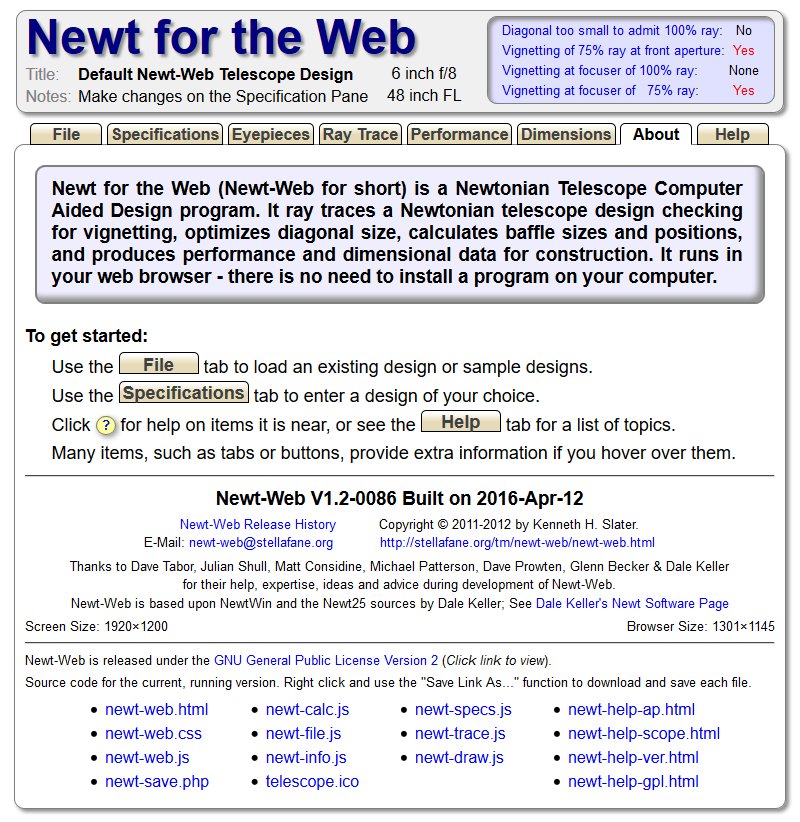
When you open the page you come to this welcome page. I will not use this tool to build my own Newton, but I can get information about what the telescope shall consist of. Maybe I do some changes of the constructions from a ready made telescope if I can't find exactly what I'm looking for.
|
2: First design 12" f/4 Newton full frame astrographAt the end it's thought that this telescope will act as a simple astrograph, that will require a big 3" coma corrector because of the full frame sensor. A Newton telescope is much more compact compare to a refractor, the camera isn't mounted at the rear, instead it's mounted on the side. Here I try to construct a compact telescope, the largest I can fit into my observatory. Open the specification page and enter your figures. In Europe we normally use the units mm, not inches.
Note: 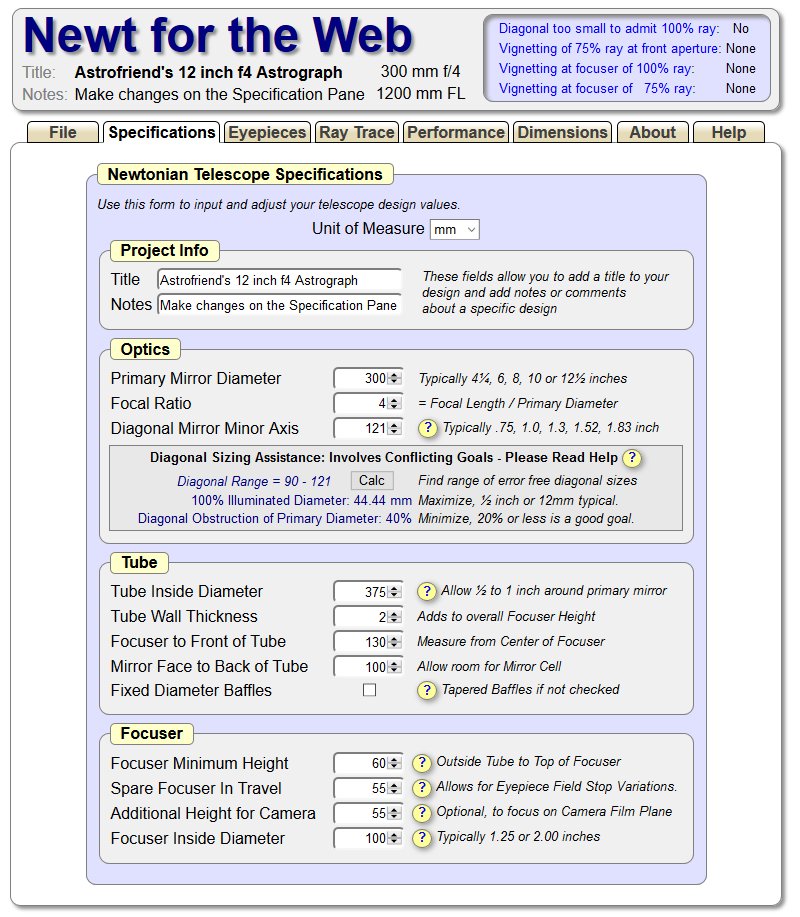
I started with the mirror diameter of 300 mm and the f/4 ratio. All the others figures I have here I have played around with by looking at the Performance page and Ray Trace page and then find the best values. 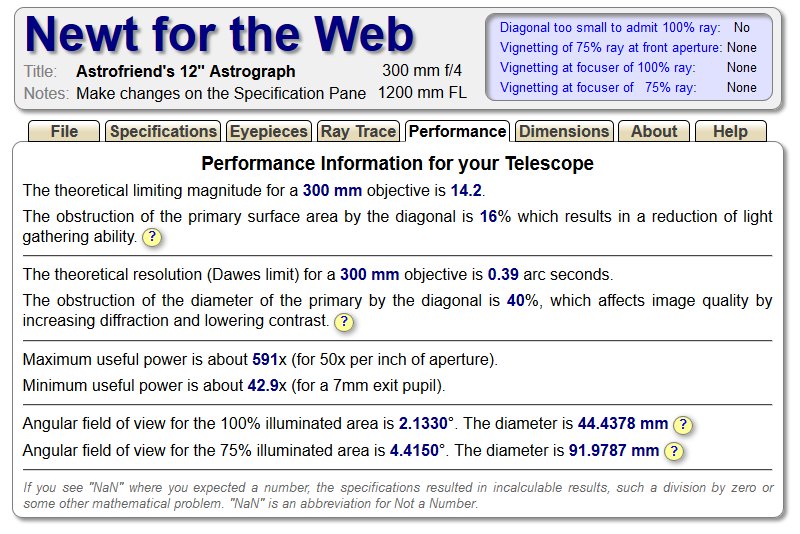
Here you can see that the 100% illuminated angular field is 44 mm in diameter. And for the 75% illumination it is huge 91 mm (good to medium format cameras). But to achieve this I need a secondary mirror with 120 mm diameter. That will not be a good telescope because the secondary obscure the primary mirror. It's diameter is 40% of the primary and that will reduce the contrast. And to not get vignetting in the focuser I need a 4" focuser and also a 4" coma corrector. 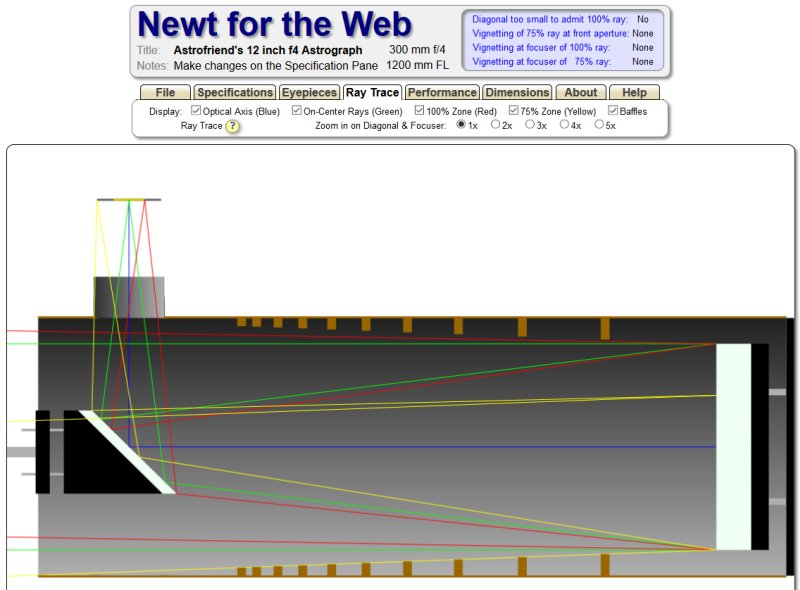
On the Ray Trace page you can follow the rays and then see why it's a need of this big focuser and coma corrector. The tube diameter must also have a size that is bigger than the mirror to let you have baffles inside the tube. You get a warning if the the size is too small. Notice that the red beam that touch the edge of full frame sensor (R = 22 mm) use the whole primary mirror, it's only the secondary mirror that block the light beam. 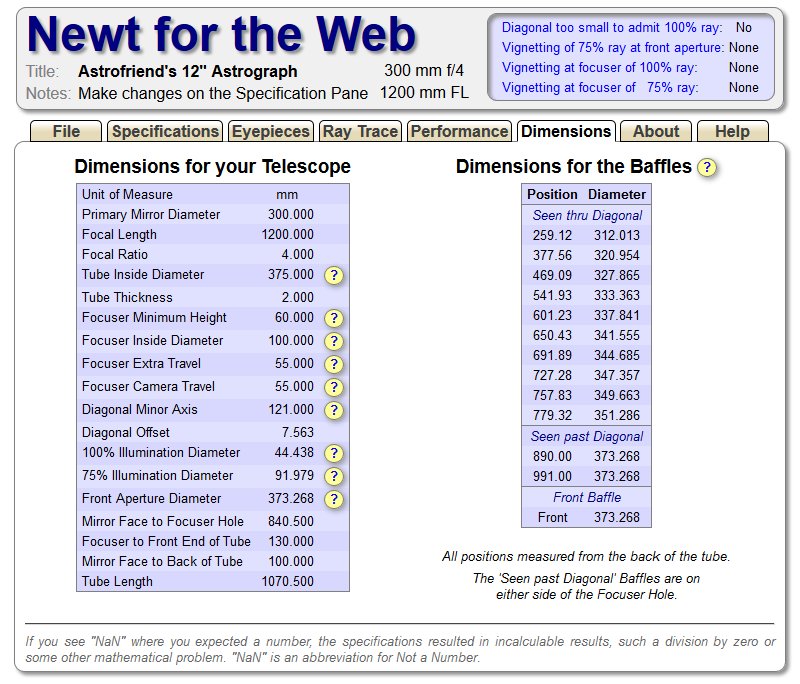
From the Dimension page I get the overall dimensions of the telescope. One critical point for me is the telescope tube length. Here 1070 mm, ok for me. Small telescope dimensions mean not that sensitive to wind blow and it fit inside my observatory. A 4" coma corrector cost about 2000 Euro and a 4" focuser I didn't even find. Have to redesign the telescope to use more common and cheaper parts.
|
3: Second design 12" f/4 Newton full frameA new design where I use more common parts and reduce the secondary mirror. If we accept more vignetting and use the 75% illuminated field, how will that look? 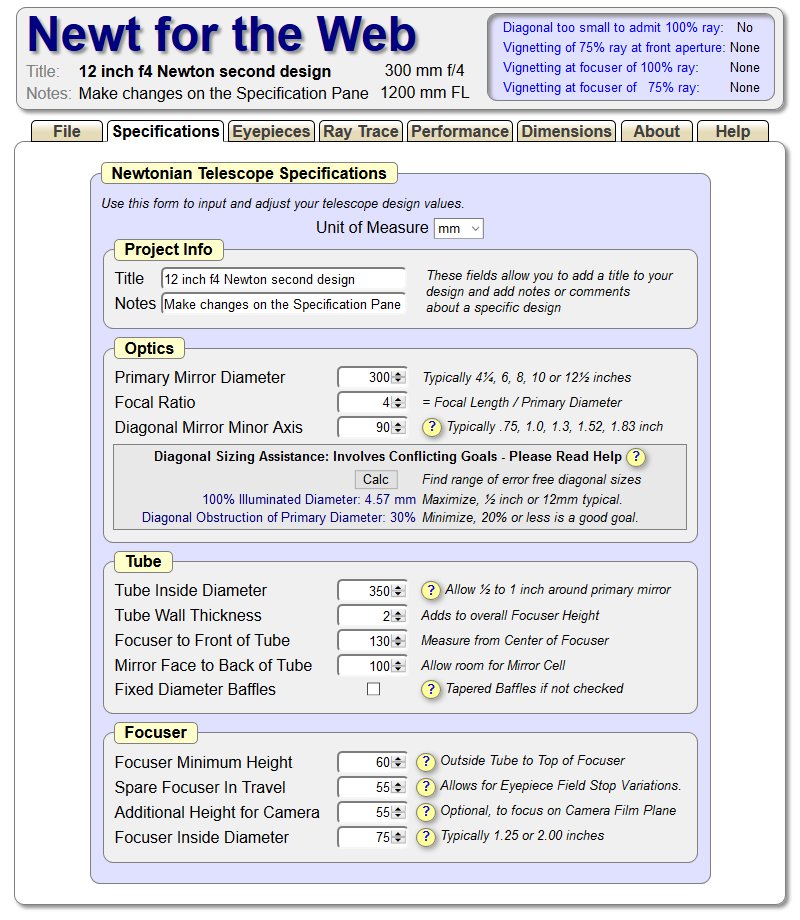
I shrunk the secondary mirror from 121 mm to 90 mm. I reduced the focuser from 4" to 3" open diameter. I also reduced the telescope tube's inside diameter to 350 mm. That will let the focal plane to come far more outside of the focuser. 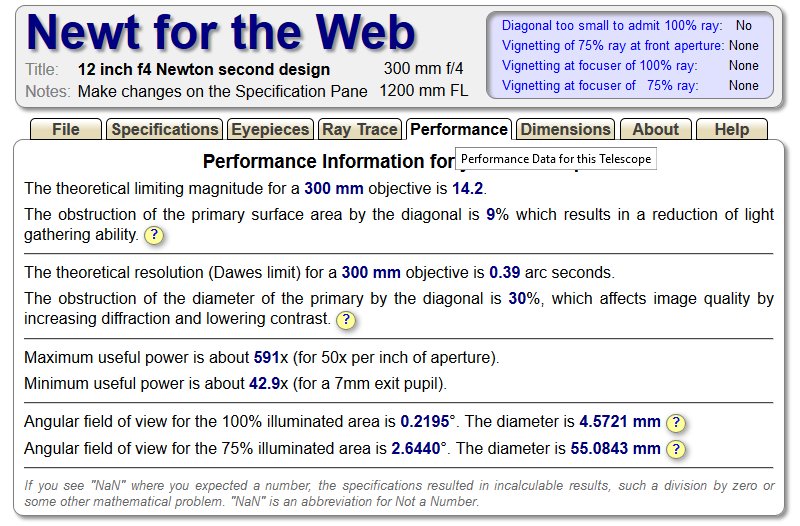
Now the diameter of the secondary is reduced to 30% of the primary mirror. The 100% illuminated angular field is now only 4.5 mm in diameter. And for the 75% illumination it's 55 mm. 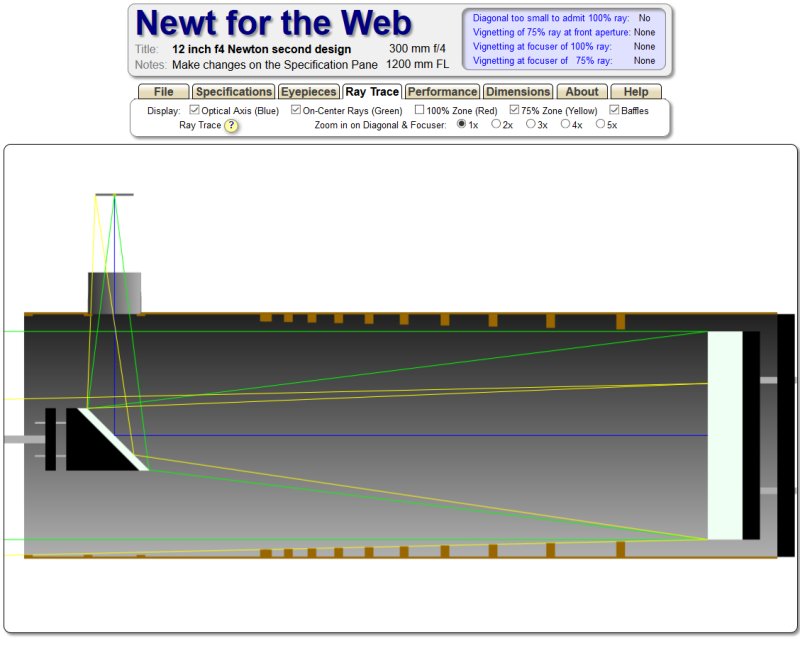
On the Ray Trace page you see that the 75% ray fits inside the focuser and secondary mirror. Notice that the yellow beam that touch the edge of full frame sensor doesn't use the whole primary mirror, and also the secondary mirror block a part of the incoming light beam. A lot of losses of light. That's why we get big vignetting problem when we use a smaller secondary mirror. 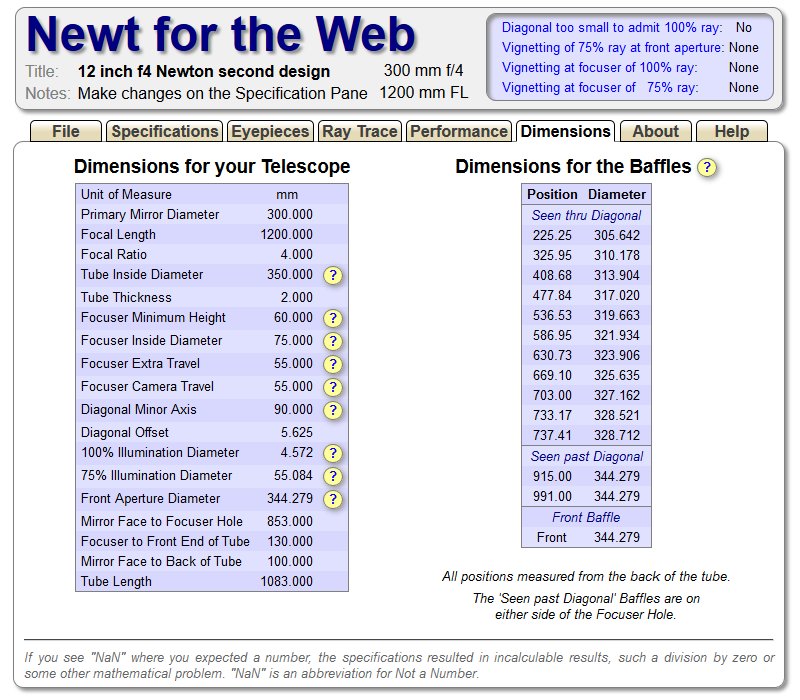
From the dimension page I get the overall dimensions of the telescope. The length of the telescope tube increased a couple of mm to 1083 mm, it's because that the secondary mirror is now farther away from the primary mirror and the focus plane is closer to the secondary mirror because of the smaller size of the telescope tube. Will this telescope be a good astrograph with a 3" coma corrector? I'm not sure, I don't have that experience to judge that yet. But a design of a telescope built by mirrors will always be a compromise compared to a refractor when you want wide angle performance. But this telescope has a long focal length and a big primary collecting mirror. You can never take the cost of a 12" f/4 refractor, we talk millions.
If you want you can download my design file here.
Newt-Web design page:
Note:
|
|